|
|
|
Grand Prix del Verano 1996
Spanish Domestic Series
Presenter / Commentator:
Ramón García
Co-Presenter:
Mar Regueras
Referees:
Almudena Fernández
Assistant Referees:
Roberto Gil
Raúl Rubio
Music:
Eduardo Leiva
Dancers:
Susana Cores
Mónica Corrales
Susana Costales
Gema González
Elena de Miguel
Ana Isabel Peralta
Noemí Ramal
Production Credits:
Creator:
Francesco Boserman
Produced by:
Europroducciones TV for Televisión Española (TVE - E)
|
Key:
Grand Prix del Verano
●
= Heat Winner
●
= Qualified for Final
Final
●
=
Gold Trophy /
●
=
Silver Trophy
▲ = Promoted to Position / ▼ =
Demoted to Position |
|
|
E |
Grand Prix del Verano
1996 |
Heat 1 |
|
Event Staged: Summer 1996
Venue:
Estudios de Prado del Rey (Prado del Rey Studios),
Avenida de Radio Televisión, Pozuelo de Alarcón, Madrid, Spain
European Transmissions (Local Timings):
TVE La 1 (E): Friday 21st June 1996
Audience Figures:
TVE La 1 (E): 4,246,000 viewers / 33.2% share |
|
Teams:
Guijuelo (Salamanca) v. Sanlúcar la Mayor (Seville) |
|
Team
Members included:
Guijuelo (Salamanca) - Tito Valverde, actor (Team Patron);
Sanlúcar la Mayor (Seville) - Norma Duval, TV personality (Team Patron). |
|
Games: The Spanish Sun, The Water Carriers, Hot Potato, The Slope (1),
Rabbits and Carrots, Sumo Basketball, The Slope (2), The Bowling Alley, The
Wig, May the Best Win! (Game of Questions). |
|
Game
Results and Standings |
|
Games |
|
Team /
Colour |
1 |
2 |
3 |
4 |
5 |
6 |
7 |
8 |
9 |
GQ |
|
Points Scored |
|
G |
4 |
4 |
1 |
0 |
3 |
4 |
1 |
2 |
0 |
+6 |
|
S |
2 |
2 |
0 |
1 |
3 |
2 |
0 |
0 |
1 |
-2 |
Running Totals
(Leading teams shown in red) |
|
G |
4 |
8 |
9 |
9 |
12 |
16 |
17 |
19 |
19 |
25 |
|
S |
2 |
4 |
4 |
5 |
8 |
10 |
10 |
10 |
11 |
9 |
|
|
|
Result |
Team |
Points |
Final Scoreboard |
|
1st
2nd |
Guijuelo (Salamanca)
● ●
Sanlúcar la Mayor (Seville) |
25
9 |
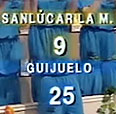 |
|
The Host
Town |
|
Madrid, Spain
Madrid is the capital city of Spain with a permanent population of around
3.3
million inhabitants, which makes it the second most populous city in the
European Union, surpassed only by Berlin in Germany, and the largest in Spain.
It is both the capital city of the Comunidad de Madrid (Community of Madrid)
and of the country of Spain, and is the seat of government, the residence of
the Spanish monarch, and is recognised as the political, economic and cultural
centre of the country. It is located 302.4km (187.9 miles) north-west of
Valencia, 391.3km (243.1 miles) north east of Sevilla, 274.2km (170.3 miles)
south west of Zaragoza and 176.1km (109.4 miles) south east of Salamanca.
Madrid is situated on the southern Meseta Central plateau, 60km south of the
Guadarrama mountain range and straddles the Jarama and Manzanares river
sub-drainage basins, in the wider Tagus River catchment area.
The Madrid area has been settled since the Stone Age and signs
remains of Lower Paleolithic human habitation, as well as Roman,
Visigoth and Muslim civilisations. Numerous ancient objects have been uncovered
in excavations along the banks of the River Manzanares, such as axes and the
remains of large mammals.
Originally named Mayrit, the city of Madrid was founded by the
emir Muhammad I of Córdoba towards the end of the ninth century and came to
prominence during the Arab occupation of the Iberian peninsula. The Emir built
a fortress on a headland near the river Manzanares, one of many built on the
border between Al-Andalus and the kingdoms of Leon and Castile, his objectives
being to protect the Toledo region from Christian invasion and also to
establish a base for Muslim offensives.
After the defeat of Toledo to Alfonso VI of Leon, the city was
conquered by Christians in 1085 during the Reconquista (Reconquest of Spain),
becoming a Crown property of the kingdom of Castile. Following the conquest,
Christians replaced Muslims in the occupation of the centre of the city, while
Muslims and Jews settled in the suburbs and all prevalent symbols of Muslim
influence and rule were removed. However, the events of this period produced a
cultural melting pot which still characterises the city today.
The 1123 Charter of Otorgamiento established the first
explicit limits between Madrid and Segovia, namely the Puerto de El Berrueco
and the Puerto de Lozoya, and in 1188, Madrid won the right to be a city with
representation in the courts of Castile. In 1202, Alfonso VIII of Castile gave
Madrid its first charter to regulate the municipal council, which was expanded
in 1222 by Ferdinand III of Castile. In 1329, King Fernando V assembled the famed Court
of Madrid for the first time. This augured in one of the darker periods in
Spanish history, namely the Spanish Inquisition. In the 14th and 15th
centuries, in the wake of the Reconquista, Moors and Jews banded together and
formed a concentrated population in Madrid – named Moreria to this day. In
1494 they were all denounced as “unbelievers” and expelled from Spain. Mosques
and other Muslim imagery once again disappeared from the area.
However it was not until the 16th century that Madrid became
Spain's capital city. King Felipe II moved the Imperial Court to Madrid in
1561, and from this time Madrid was now the kingdom's capital, apart from the
brief years between 1601 and 1606 when Felipe III installed his court in
Valladolid.
Madrid enjoyed significant changes during the 18th century,
when city gates, bridges and new buildings gave it a new appearance. The Royal
Palace (also called the Eastern Palace - Palacio de Oriente, standing next to
the large Plaza de Oriente square) was constructed on the site of the ruins of
the Alcazar or old Moorish Castle which had been destroyed by fire in 1734.
After 1738 Juan B. Sachetti directed the construction work on the Palace,
helped out to some extent by Ventura Rodríguez and developing on original
plans made by Juavera. The work on the Royal Palace was completed during the
reign of Carlos III (1759-1788), as was the construction of the city gates,
the Royal Theatre, the building that now houses the Ministry of Finance
(Hacienda), the Natural Science Museum, the Botanical Gardens and the temple
of San Francisco El Grande, amongst others. Also, the Retiro Park was
significantly improved and several new buildings built: Casa de Cisneros, the
General Hospital, the College of San Carlos, the Royal Mint, Casa de los
Geranios and the fountains of Cibeles, Neptune and Apollo.
On 27th October 1807, Charles IV and Napoleon I signed the Treaty of
Fontainebleau, which permitted French troops to pass through Spanish
territory to join the Spanish troops and invade Portugal, which had defied an
international blockade against England. As this was happening, there was the
Mutiny of Aranjuez (17th March 1808), by which the crown prince, Ferdinand
VII, replaced his father as king. However, Joachim-Napoléon Murat, a Marshal
of the French Empire, took advantage of the weakness of the Spanish Bourbons,
and forced both father and son, to join him in Bayonne in late April. In the
absence of the two kings, the situation became more and more tense in Madrid.
On 2nd May, a crowd gathered at the Royal Palace and set upon the French
soldiers there. The fight lasted for many hours and spread throughout Madrid.
The subsequent repression by the French was brutal. In the Paseo del Prado and
in the fields of La Moncloa hundreds of patriots were shot due to Murat's
order against "All Spaniards carrying arms". Paintings such as The Third of
May 1808 by Goya reflect the repression that ended the popular uprising on
2nd May. This proved to be the beginning of the War of Independence, a
large-scale war in which the Spanish fought against Napoleon and their former
allies in France, which has given rise to a number of patriotic memorials in
the city of Madrid. The Plaza Dos de Mayo is the most famous of these. In
1835, the world-famous University of Alcala de Henares was transferred to
Madrid. The Faculty of Science was added to it, and the academy became the
Universidad Complutense de Madrid (UCM).
During the Spanish Civil War (1936-1939), Madrid was held by
forces loyal to the Spanish Republic. Following the advance towards Madrid of
rebel land troops, the first air bombings on the city started on the night of
the 27th-28th August 1936, leaving it with the dubious honour of being the
first major European city to be bombed by aviation. The summer and autumn of
1936 saw the Republican Madrid witness heavy-handed repression by Communist
and Socialist groups, symbolised by the horrific Paracuellos massacres during
a major rebel offensive against the city, which was halted by early December.
Even towards the end of the war, Madrid witnessed great suffering and even a
minor civil war that accounted for roughly 2,000 lives between 5th and 10th
March 1939. The city fell to the nationalists on 28th March 1939 and,
following the onset of the Françoist dictatorship in the city, the absence of
freedoms and the brutal repression of those linked to a republican past
greatly affected life in the city. There was a climate of general shortage,
with ration coupons rampant and a lingering autocratic economy which lasted
until the mid-1950s.
After centuries of historical tumult, Madrid has made
tremendous urban progress in recent years. It is considered one of Europe’s
most progressive, modern and beautiful cities. It has a vibrant local arts
culture and boisterous nightlife, along with constant reminders of the city’s
rich history. It is deservedly renowned as one of the continent’s most
favoured tourist destinations. |
|
The Venue |
|
Estudios de Prado del Rey
(Prado del Rey Studios)
The games were played in a giant, specially-erected tent in the
grounds of the Estudios de Prado del Rey in Madrid. It was put up to house
major productions that required a large space for sets and audience seating.
Several programmes were recorded there, such as the Spanish version of the
game show ¿Qué Apostamos? (What Do You Bet?). The studio complex
is the main headquarters of the public service broadcaster Corporación de
Radio y Televisión Española (Spanish Radio and Television Corporation, RTVE).
It was built in 1964 to replace the previous headquarters of the TVE
television service which had been located on Paseo de la Habana in the
Chamartín district of Madrid. At the time of construction, Studio 1 - the main
studio at Prado del Rey - was one of the largest televisions studios in the
world with a floor space of 1,200 square metres.
From November 1966, the Estudios de Prado del Rey became the site of all
production for the second channel of TVE, which quickly became known
colloquially as UHF due to its method of transmission via Ultra High Frequency
technology. The channel has gone by many names over the years - Cadena II,
Segunda Cadena, Segundo Programa and TVE-2 - until in the 1990s, when, with
the advent of commercial television, it was rebranded as La 2 and this name
persists today.
The
headquarters of Radio Nacional de España (RNE) was moved in 1971 to the site
where it was installed in a unit attached to the main building which became
known as Casa de la Radio (Radio House).
In 1972, with the official premiere of the color broadcasts in
Spain after two years of test transmissions, a specific building was
constructed at Prado del Rey for the production of colour programming. The
older studios on site were gradually upgraded to be made colour-capable, but
as this project was carried out, much of the output of Estudios de Prado del
Rey remained in monochrome. As the decade progressed, the ratio of colour
programming to black-and-white increased, with monochrome productions finally
phased out completely from 1977.
In common with many television studios around the world, the
Prado del Rey complex has been affected by changes in the way in which
television is produced and also by the passing of time. In 1995, it was
discovered that some of the studio buildings were affected by aluminosis (the
progressive deterioration of concrete which was made from alumina cement,
leading to structural degradation of joists and supports) and some studios had
to be closed, including Studio 1. Following repairs, normal activity resumed.
Later, in October 2011, following complaints from workers' unions, it was
decided to demolish all the buildings that had employed asbestos in their
construction, as this posed a significant health risk for RTVE workers. This
measure led to the destruction of the old colour studios, as well as the
dressing rooms, the set and prop store, the air conditioning plant and the
crane warehouse.
However, unlike many other famous television productions
centres around the world which have either been completely demolished or
turned into luxury apartment complexes, the Estudios del Prado del Rey remain
operational today. Partly this is down to the financial crash of 2008, which
brought to an end the plans to build a giant RTVE headquarters elsewhere in
the capital city, which would replace Prado del Rey and two other RTVE studios
- Buñuel and Torrespaña - and bring all their productions under one roof. It
was decided instead to modernise and restructure the existing facilities. The
Estudios Buñuel were finally closed in 2014 and sold in 2015, with their
productions moved to Prado del Rey. This coincided with further studio
demolitions at Prado del Rey and the construction of new, more modern
production spaces. |
|
Made
in Colour • This programme exists in TVE Archives |
|
|
|
E |
Grand Prix del Verano
1996 |
Heat 2 |
|
Event Staged: Summer 1996
Venue:
Estudios de Prado del Rey (Prado del Rey Studios),
Avenida de Radio Televisión, Pozuelo de Alarcón, Madrid, Spain
European Transmissions (Local Timings):
TVE La 1 (E): Friday 28th June 1996
Audience Figures:
TVE La 1 (E): 4,282,000 viewers / 33.7% share |
|
Teams:
Jarandilla de la Vera (Cáceres) v. Sabiñánigo (Huesca) |
|
Team
Members included:
Jarandilla de la Vera (Cáceres) - Joaquín Kremel, actor (Team Patron);
Sabiñánigo (Huesca) - Juncal Rivero, model and TV personality (Team Patron). |
|
Games: The Arches, The Fish Market, The Sumo Statues, Hot Potato, The
Slope (1), A Squishy Diet, The Slope (2), The Bowling Alley, The Wig, May the
Best Win! (Game of Questions). |
|
Game
Results and Standings |
|
Games |
|
Team /
Colour |
1 |
2 |
3 |
4 |
5 |
6 |
7 |
8 |
9 |
GQ |
|
Points Scored |
|
J |
3 |
2 |
2 |
1 |
1 |
2 |
0 |
2 |
1 |
-6 |
|
S |
3 |
4 |
4 |
0 |
0 |
4 |
1 |
0 |
0 |
+6 |
Running Totals
(Leading teams shown in red) |
|
J |
3 |
5 |
7 |
8 |
9 |
11 |
11 |
13 |
14 |
8 |
|
S |
3 |
7 |
11 |
11 |
11 |
15 |
16 |
16 |
16 |
22 |
|
|
|
Result |
Team |
Points |
Final Scoreboard |
|
1st
2nd |
Sabiñánigo (Huesca)
● ●
Jarandilla de la Vera (Cáceres) |
22
8 |
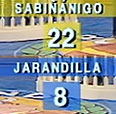 |
|
Additional Information |
|
The team of Sabiñánigo (Huesca) qualified for the final despite
scoring the same total as Salvatierra (Álava) went on to achieve in Heat 4.
The Sabiñánigo team qualified as they had a greater winning margin (14pts)
than Salvatierra managed (only 7pts).
The final result gives the impression that this was a runaway
victory for the Sabiñánigo team. However, it was actually a tight contest
until the final questions round, when Sabiñánigo got all their questions right
and Jarandilla de la Vera got all theirs wrong! |
|
Made
in Colour • This programme exists in TVE Archives |
|
|
|
E |
Grand Prix del Verano
1996 |
Heat 3 |
|
Event Staged: Summer 1996
Venue:
Estudios de Prado del Rey (Prado del Rey Studios),
Avenida de Radio Televisión, Pozuelo de Alarcón, Madrid, Spain
European Transmissions (Local Timings):
TVE La 1 (E): Friday 5th July 1996
Audience Figures:
TVE La 1 (E): 4,099,000 viewers / 33.3% share |
|
Teams:
L'Alfàs del Pi (Alicante) v. Villafranca (Navarra) |
|
Team
Members included:
L'Alfàs del Pi (Alicante) - Mabel Lozano, TV personality (Team Patron);
Villafranca (Navarra) - Fernando Romay, former basketball player (Team Patron). |
|
Games: The Dice, The Magic Carpet, Hens and Wolves, Hot Potato, The Slope
(1), The Water Carriers, The Slope (2), Bowling Pins, The Wig, May the Best Win! (Game of Questions). |
|
Game
Results and Standings |
|
Games |
|
Team /
Colour |
1 |
2 |
3 |
4 |
5 |
6 |
7 |
8 |
9 |
GQ |
|
Points Scored |
|
A |
4 |
2 |
2 |
1 |
2 |
2 |
1 |
2 |
0 |
+2 |
|
V |
2 |
4 |
4 |
0 |
0 |
4 |
0 |
0 |
1 |
-2 |
Running Totals
(Leading teams shown in red) |
|
A |
4 |
6 |
8 |
9 |
11 |
13 |
14 |
16 |
16 |
18 |
|
V |
2 |
6 |
10 |
10 |
10 |
14 |
14 |
14 |
15 |
13 |
|
|
|
Result |
Team |
Points |
Final Scoreboard |
|
1st
2nd |
L'Alfàs
del Pi (Alicante)
●
Villafranca (Navarra) |
18
13 |
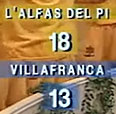 |
|
Additional Information |
|
The team of Villafranca (Navarra) was disqualified from the
first game - 'The Dice' - because in the rules, the dice had to be thrown by
the vachette - and their player had thrown it himself.
This contest witnessed the first time in the 1996 series that
any of the competitors was able to finish 'The Slope (Round 1)', scoring 2
points instead of 1.
The team of L'Alfas del Pi (Alicante) brought a dulzaina player
- a kind of bagpipe - and he kept playing the instrument throughout the
programme, especially when his team won a game. |
|
Made
in Colour • This programme exists in TVE Archives |
|
|
|
E |
Grand Prix del Verano
1996 |
Heat 4 |
|
Event Staged: Summer 1996
Venue:
Estudios de Prado del Rey (Prado del Rey Studios),
Avenida de Radio Televisión, Pozuelo de Alarcón, Madrid, Spain
European Transmissions (Local Timings):
TVE La 1 (E): Friday 12th July 1996
Audience Figures:
TVE La 1 (E): 4,246,000 viewers / 36.6% share |
|
Teams:
Moratalla (Murcia) v. Salvatierra-Agurain (Álava) |
|
Team
Members included:
Moratalla (Murcia) - Eloy Arenas, comedian (Team Patron);
Salvatierra-Agurain (Álava) - Cristina Almeida, politician (Team Patron). |
|
Games: The Breakfast, The Thieves, Sumo Wrestlers and Watermelons, Hot
Potato, The Slope (1), The Cruise, The Slope (2), Bowling Pins, The Wig, May the Best Win! (Game of Questions). |
|
Game
Results and Standings |
|
Games |
|
Team /
Colour |
1 |
2 |
3 |
4 |
5 |
6 |
7 |
8 |
9 |
GQ |
|
Points Scored |
|
M |
4 |
3 |
2 |
0 |
0 |
2 |
1 |
1 |
0 |
+2 |
|
S |
2 |
3 |
4 |
1 |
1 |
4 |
0 |
1 |
0 |
+6 |
Running Totals
(Leading teams shown in red) |
|
M |
4 |
7 |
9 |
9 |
9 |
11 |
12 |
13 |
13 |
15 |
|
S |
2 |
5 |
9 |
10 |
11 |
15 |
15 |
16 |
16 |
22 |
|
|
|
Result |
Team |
Points |
Final Scoreboard |
|
1st
2nd |
Salvatierra-Agurain
(Álava)
●
Moratalla (Murcia) |
22
15 |
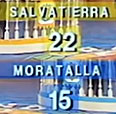 |
|
Additional Information |
|
The team of Salvatierra-Agurain (Álava) narrowly missed out on
qualification for the Final. They equalled the score Sabiñánigo (Huesca)
achieved in Heat 2 but lost out as the Sabiñánigo team achieved a greater
winning margin (14pts) than Salvatierra-Agurain managed (only 7pts).
The Salvatierra-Agurain (Álava) team was referred to by that
name in this programme as Salvatierra is the Spanish name for the town while
Agurain is its Basque name. Both names are used officially.
In 'The Slope (Round 1)', the Moratalla player was in the lead
for most of the contest, but with just two seconds to go until the end of the
game he fell, resulting in a victory for the Salvatierra-Agurain player.
In the penultimate game - 'The Wig' - none of the players were
able to find the wig amongst the audience members, so no points were awarded. |
|
Made
in Colour • This programme exists in TVE Archives |
|
|
|
E |
Grand Prix del Verano
1996 |
Heat 5 |
|
Event Staged: Summer 1996
Venue:
Estudios de Prado del Rey (Prado del Rey Studios),
Avenida de Radio Televisión, Pozuelo de Alarcón, Madrid, Spain
European Transmissions (Local Timings):
TVE La 1 (E): Friday 19th July 1996
Audience Figures:
TVE La 1 (E): 4,392,000 viewers / 40.0% share |
|
Teams:
Rascafría (Madrid) v. Sant Antoni (Ibiza) |
|
Team
Members included:
Rascafría (Madrid) - Eva Cobo (Team Patron);
Sant Antoni (Ibiza) - José Luis Coll (Team Patron). |
|
Game
Results and Standings |
|
Result |
Team |
Points |
Final Scoreboard |
|
1st
2nd |
Sant
Antoni (Ibiza)
●
Rascafría (Madrid) |
19
15 |
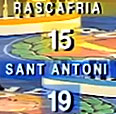 |
|
Made
in Colour • This programme exists in TVE Archives |
|
|
|
E |
Grand Prix del Verano
1996 |
Heat 6 |
|
Event Staged: Summer 1996
Venue:
Estudios de Prado del Rey (Prado del Rey Studios),
Avenida de Radio Televisión, Pozuelo de Alarcón, Madrid, Spain
European Transmissions (Local Timings):
TVE La 1 (E): Friday 26th July 1996
Audience Figures:
TVE La 1 (E): 3,311,000 viewers / 31.0% share |
|
Teams:
El Sauzal (Tenerife) v. Platja D'Aro (Gerona) |
|
Team
Members included:
El Sauzal (Tenerife) - Laura Valenzuela (Team Patron);
Platja D'Aro (Gerona) - Paco Clavel (Team Patron). |
|
Game
Results and Standings |
|
Result |
Team |
Points |
Final Scoreboard |
|
=1st
=1st |
El
Sauzal (Tenerife)
●
Platja D'Aro (Gerona)
● |
15
15 |
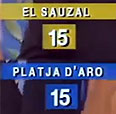 |
|
Made
in Colour • This programme exists in TVE Archives |
|
|
|
E |
Grand Prix del Verano
1996 |
Heat 7 |
|
Event Staged: Summer 1996
Venue:
Estudios de Prado del Rey (Prado del Rey Studios),
Avenida de Radio Televisión, Pozuelo de Alarcón, Madrid, Spain
European Transmissions (Local Timings):
TVE La 1 (E): Friday 2nd August 1996
Audience Figures:
TVE La 1 (E): 3,257,000 viewers / 30.1% share |
|
Teams:
Alameda (Málaga) v. Illescas (Toledo) |
|
Team
Members included:
Alameda (Málaga) - Remedios Cervantes (Team Patron);
Illescas (Toledo) - Pedro Ruiz (Team Patron). |
|
Game
Results and Standings |
|
Result |
Team |
Points |
Final Scoreboard |
|
1st
2nd |
Alameda
(Málaga)
●
Illescas
(Toledo) |
15
10 |
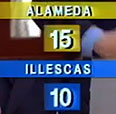 |
|
Made
in Colour • This programme exists in TVE Archives |
|
|
|
E |
Grand Prix del Verano
1996 |
Heat 8 |
|
Event Staged: Summer 1996
Venue:
Estudios de Prado del Rey (Prado del Rey Studios),
Avenida de Radio Televisión, Pozuelo de Alarcón, Madrid, Spain
European Transmissions (Local Timings):
TVE La 1 (E): Saturday 10th August 1996
Audience Figures:
TVE La 1 (E): 2,928,000 viewers / 38.7% share |
|
Teams:
Laredo (Cantabria) v. Tarazona (Zaragoza) |
|
Team
Members included:
Laredo (Cantabria) - Cristina García Ramos (Team Patron);
Tarazona (Zaragoza) - Monty el Mago (Team Patron). |
|
Game
Results and Standings |
|
Result |
Team |
Points |
Final Scoreboard |
|
1st
2nd |
Laredo
(Cantabria)
●
Tarazona (Zaragoza) |
19
15 |
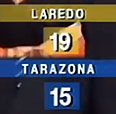 |
|
Made
in Colour • This programme exists in TVE Archives |
|
|
|
E |
Grand Prix del Verano
1996 |
Heat 9 |
|
Event Staged: Summer 1996
Venue:
Estudios de Prado del Rey (Prado del Rey Studios),
Avenida de Radio Televisión, Pozuelo de Alarcón, Madrid, Spain
European Transmissions (Local Timings):
TVE La 1 (E): Friday 16th August 1996
Audience Figures:
TVE La 1 (E): 3,148,000 viewers / 33.5% share |
|
Teams:
Betxí (Castellón) v. Muros de Nalón (Asturias) |
|
Team
Members included:
Betxí (Castellón) - Esther Arroyo (Team Patron);
Muros de Nalón (Asturias) - Marianico El Corto (Team Patron). |
|
Game
Results and Standings |
|
Result |
Team |
Points |
Final Scoreboard |
|
=1st
=1st |
Betxí
(Castellón)
●
Muros de Nalón (Asturias)
● |
15
15 |
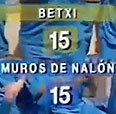 |
|
Made
in Colour • This programme exists in the TVE Archives |
|
|
|
E |
Grand Prix del Verano
1996 |
Heat 10 |
|
Event Staged: Summer 1996
Venue:
Estudios de Prado del Rey (Prado del Rey Studios),
Avenida de Radio Televisión, Pozuelo de Alarcón, Madrid, Spain
European Transmissions (Local Timings):
TVE La 1 (E): Friday 23rd August 1996
Audience Figures:
TVE La 1 (E): 3,587,000 viewers / 36.2% share |
|
Teams:
Arnedo (La Rioja) v. Villaconejos (Madrid) |
|
Team
Members included:
Arnedo (La Rioja) - Carla Duval (Team Patron);
Villaconejos (Madrid) - Guillermo Summers (Team Patron). |
|
Game
Results and Standings |
|
Result |
Team |
Points |
Final Scoreboard |
|
1st
2nd |
Villaconejos
(Madrid)
●
Arnedo (La Rioja) |
15
12 |
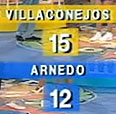 |
|
Team
Personnel |
|
Guillermo Summers, Team Patron for the Villaconejos (Madrid) team in this
heat, was a Grand Prix del Verano team patron on four separate
occasions, subsequently appearing in its 1997, 2000 and 2003 series. He had an
excellent pedigree, having been one of the TVE presenters for the 1988 series
of Jeux Sans Frontières. |
|
Returning Teams and Competitors |
|
By
appearing in this programme, the
team of Arnedo (La Rioja) became the first town to have competed in both Jeux Sans
Frontières (1990, Heats 3 and 7) and in Grand Prix del Verano. |
|
Made
in Colour • This programme exists in TVE Archives |
|
|
|
E |
Grand Prix del Verano
1996 |
Heat 11 |
|
Event Staged: Summer 1996
Venue:
Estudios de Prado del Rey (Prado del Rey Studios),
Avenida de Radio Televisión, Pozuelo de Alarcón, Madrid, Spain
European Transmissions (Local Timings):
TVE La 1 (E): Friday 30th August 1996
Audience Figures:
TVE La 1 (E): 4,465,000 viewers / 35.3% share |
|
Teams:
Beas de Segura (Jaén) v. Peñaranda de Duero (Burgos) |
|
Team
Members included:
Beas de Segura (Jaén) - Terelu Campos (Team Patron);
Peñaranda de Duero (Burgos) - Manuel Díaz (Team Patron). |
|
Game
Results and Standings |
|
Result |
Team |
Points |
Final Scoreboard |
|
1st
2nd |
Beas
de Segura (Jaén)
●
Peñaranda de Duero (Burgos) |
20
10 |
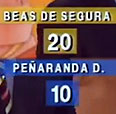 |
|
Made
in Colour • This programme exists in TVE Archives |
|
|
|
E |
Grand Prix del Verano
1996 |
Heat 12 |
|
Event Staged: Summer 1996
Venue:
Estudios de Prado del Rey (Prado del Rey Studios),
Avenida de Radio Televisión, Pozuelo de Alarcón, Madrid, Spain
European Transmissions (Local Timings):
TVE La 1 (E): Friday 6th September 1996
Audience Figures:
TVE La 1 (E): 3,880,000 viewers / 31.3% share |
|
Teams:
El Perelló (Tarragona) v. Viveiro (Lugo) |
|
Team
Members included:
El Perelló (Tarragona) - Ana García Obregón (Team Patron);
Viveiro (Lugo) - Carlos Iglesias (Team Patron). |
|
Game
Results and Standings |
|
Result |
Team |
Points |
Final Scoreboard |
|
1st
2nd |
El
Perelló (Tarragona)
●
Viveiro (Lugo) |
19
18 |
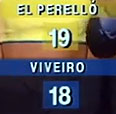 |
|
Made
in Colour • This programme exists in TVE Archives |
|
|
|
E |
Grand Prix del Verano
1996 |
Final |
|
Event Staged: Summer 1996
Venue:
Estudios de Prado del Rey (Prado del Rey Studios),
Avenida de Radio Televisión, Pozuelo de Alarcón, Madrid, Spain
European Transmissions (Local Timings):
TVE La 1 (E): Friday 13th September 1996
Audience Figures:
TVE La 1 (E): 4,758,000 viewers / 33.3% share |
|
Teams:
Guijuelo (Salamanca) v. Sabiñánigo (Huesca) |
|
Team
Members included:
Guijuelo (Salamanca) - Los del Río (Team Patron);
Sabiñánigo (Huesca) - Ángeles Martín (Team Patron). |
|
Game
Results and Standings |
|
Result |
Team |
Points |
Final Scoreboard |
|
1st
2nd |
Guijuelo
(Salamanca)
●
Sabiñánigo (Huesca)
● |
19
9 |
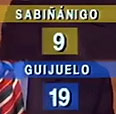 |
|
Made
in Colour • This programme exists in TVE Archives |
|
|
|
JSFnetGB Series Guide pages researched by
Neil Storer and
Alan Hayes
with Ischa Bijl, Julien Dessy, Sébastien Dias, David Hamilton, Denis Kirsanov, Paul Leaver, Philippe Minet,
Christos Moustakas, David Laich Ruiz, Marko Voštan and JSFnet Websites |
|
|